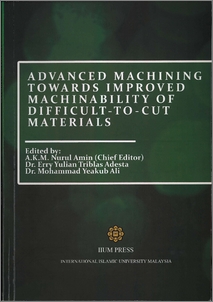Ginta, Turnad Lenggo and Amin, A. K. M. Nurul and Ishtiyaq, M. H.
(2011)
Comparison of surface roughness in end milling of titanium alloy Ti-6Al-4V using uncoated WC-Co and PCD inserts through generation of models.
In:
Advanced Machining Towards Improved Machinability of Difficult-to-Cut Materials.
IIUM Press, International Islamic University Malaysia, Kuala Lumpur, Malaysia, pp. 189-194.
ISBN 9789674181758
![[img]](http://irep.iium.edu.my/style/images/fileicons/application_pdf.png)  Preview |
|
PDF ( Comparison of surface roughness in end milling of titanium alloy Ti-6Al-4V using uncoated WC-Co and PCD inserts through generation of models)
- Published Version
Download (570kB)
| Preview
|
Abstract
Titanium alloys are widely known as difficult to cut materials, especially at higher cutting
speeds, due to their several inherent properties. Siekmann [1] suggested that machining of
titanium and its alloys would always be a problem, no matter what techniques are employed to
transform this metal into chips. When machining Ti-6Al-4V, conventional tools wear rapidly
because the poor thermal conductivity of titanium alloys resulting in higher cutting temperature
closer to the cutting edge. There also exists strong adhesion between the tool and workpiece
material [2]. Since the performance of conventional tools is poor in machining Ti-6Al-4V, a
number of newly evolved tool materials, such as cubic boron nitride (CBN) and polycrystalline
diamond (PCD), are being considered to achieve high-speed milling [3]. A machinability model
may be defined as a functional relationship between the input of independent cutting variables
(speed, feed, depth of cut) and the output known as responses (tool life, surface roughness,
cutting force, etc) of a machining process [4]. Response surface methodology (RSM) is a
combination of experimental and regression analysis and statistical inference. RSM is a dynamic
and foremost important tool of design of experiment (DOE), wherein the relationship between
response(s) of a process with its input decision variables is mapped to achieve the objective of
maximization or minimization of the response properties [5-6]. Many machining researchers
have used response surface methodology to design their experiments and assess results. Kaye et
al [7] used response surface methodology in predicting tool flank wear using spindle speed
change. A unique model has been developed which predicts tool flank wear, based on the spindle
speed change, provided the initial flank wear at the beginning of the normal cutting stage is
known. An empirical equation has also been derived for calculating the initial flank wear, given
the speed, feed rate, depth of cut and workpiece hardness. Alauddin et al [8] applied response
surface methodology to optimize the surface finish in end milling of Inconel 718 under dry
condition. They developed contours to select a combination of cutting speed, and feed without
increasing the surface roughness.
Fuh and Wang [9] developed a model for predicting milling force model in end milling
operation. They found that the proposed model is suitable for practical engineering application,
since the milling force analyzed in the model has already encompassed the structural characteristics of the milling machine and the real conditions of the tool and workpiece. They
also suggested that the proposed force model had a good correlation with experimental values.
Choudhury and el-Baradie [10] found that response surface methodology combined with the
factorial design of experiments were useful techniques for tool life testing. Relatively, a small
number of designed experiments are required to generate much useful information that can be
used for developing the predicting equation for tool life. Mansour and Abdalla [11] developed a
surface roughness model for end milling of a semi-free cutting carbon casehardened steel. They
investigated a first-order equation covering the speed range 30 – 35 m/min and a second order
generation equation covering the speed range 24 – 38 m/min. They suggest that an increase in
either the feed or the axial depth of cut increases the surface roughness, whilst an increase in the
cutting speed decreases the surface roughness. Oktem et al [12] used response surface
methodology with a developed genetic algorithm (GA) in the optimization of cutting conditions
for surface roughness. S. Sharif et al [13] used factorial design coupled with response surface
methodology in developing the surface roughness model in relation to the primary machining
variables such as cutting speed, feed, and radial rake angle.
In this paper, the RSM technique is used in developing a mathematical model to optimize the
surface roughness values when end milling titanium alloy using both uncoated WC-Co and PCD
inserts under dry conditions. Factorial design coupled with response surface methodology is utilized to
develop the model for predicting surface roughness values.
Actions (login required)
 |
View Item |


 Download Statistics
Download Statistics Download Statistics
Download Statistics